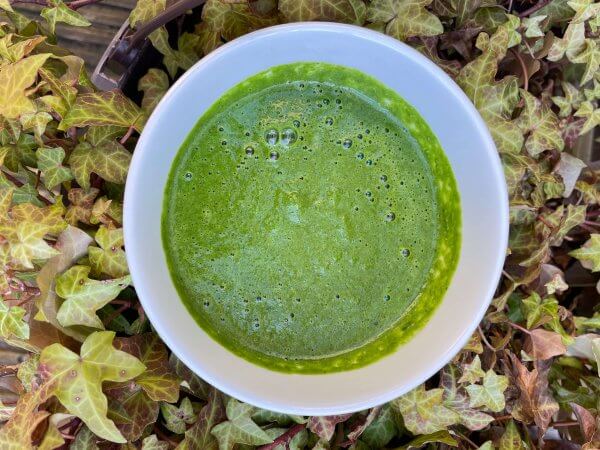Gujarati lili chatni is a beautiful thing. As green as the greenest grass, it is a shiny, sparkling emerald pool, spicy, satisfying, and versatile. This recipe is my mother’s, which she has perfected over many years since she first began to cook as a young girl in India. Lili chatni has been a regular fixture in her fridge for as long as I can remember. Everyone, including my children, devours it! During family get togethers, it is eaten with such speed and frenzy, that it often runs out in seconds. Believe me, not matter how delicious my mother’s food is (and it always is), when there is no lili chutney, something seems to be missing.

Soul food
Lili chatni soothes the soul, cures the blues, and awakens the digestive enzymes. It can be stored in the fridge for several days, or frozen in small batches in ice cube trays. This means you can take out just enough, as and when you need it. The recipe makes enough to use as part of a meal and have plenty left over to store. Lili chatni is traditionally eaten as an accompaniment to many Indian snacks, both hot and cold, such as red onion pakoras, which I often make for my Ayurvedic supper clubs, or for friends to have with drinks. You will soon realise how much it enhances, and suits, so many foods. Here are some tried and tested ideas:
To accompany my spiced crumpets
As a dip for pakoras/bhajis
Spread over melted cheese toast.
Smeared over chicken or fish as a marinade
Lili chatni, enough for many servings (or to freeze to use later)
Ingredients:
2 large bunches fresh coriander leaves, and thin stalks, washed well, and chopped (discard the thick stalks)
2 small green chillies, chopped
1 inch piece of fresh ginger, peeled
4 oz unsalted, skinned peanuts
3 tbsp desiccated coconut
1 tsp cumin seeds
3 tbsp lemon juice
6 ½ level tsp sugar
1 ½ tsp salt
Water
Method:
Grind everything except the coriander and salt in a liquidiser, adding tiny amounts of water just enough to allow the smooth movement of the ingredients. Once it starts to grind more readily, add a small amount of the chopped coriander leaves, stop and open the lid, and using a spatula, mix everything together. Again, add a little water as needed, and liquidise once more.
Now add the rest of the coriander in small batches. Get into a rhythm of liquidising, adding coriander and just enough water to allow the smooth movement of the ingredients. The water should not be seen as a main ingredient, but just a facilitator to smoothly grind everything, so be careful not to add more than is needed.
The chatni should be smooth but not watery, with a pouring consistency rather like gravy. If you find it is too thick, add a little more water.
Add the salt, check and adjust lemon juice, sugar and salt, and liquidise once more.
Utterly wholesome, delicious, and versatile.
